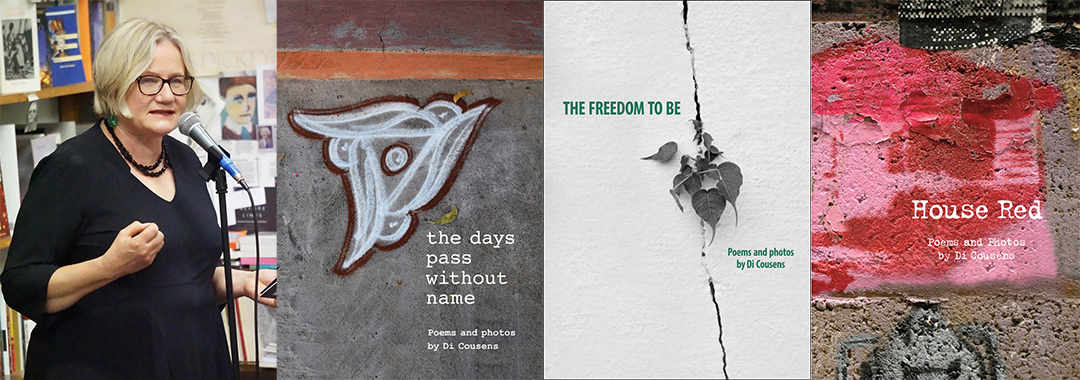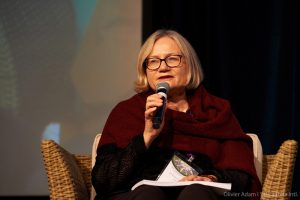 디 쿠젠스 Di Cousens
디 쿠젠스 Di Cousens
[세계 속 붓다의 딸 #10] 샤카디타 호주의 초대 회장인 디 쿠젠스는 오랜기간 대학에서 프로젝트 매니저와 작가로 일했다. 시집을 발간하고 사진 전시회도 개최한 바 있다. 예술과 티베트 역사를 전공하였으며 히말라야 연구로 박사학위를 받았다. 호주의 '빅토리아 주 불교회'의 전 부회장을 지내기도 했다. 특히 '죽음을 위한 불교적 치료'를 발행하여 빅토리아 주에 있는 모든 병원과 요양원, 교도소에 배포했다. 또한 7개 언어로 된 장애인을 위한 사찰 안내서를 만들어 호주 전역에 배포하였다. * 디 쿠젠스 개인 홈페이지 /샤카디타 호주 홈페이지 / 호주 빅토리아 주 불교회 홈페이지
* 인터뷰: 시드니 탐슨, *번역: 정형은
시드니 Sydney:
![]() 어떤 일을 하시는지 간단히 소개해주세요.
어떤 일을 하시는지 간단히 소개해주세요.
Could you briefly introduce yourself and what you’re currently doing or working on?
디 쿠젠스 Di Cousens:
![]() 저는 호주 ‘빅토리아주(州) 불교회’의 위원입니다. 빅토리아 주에 위치한 중국, 한국, 미얀마, 태국, 스리랑카, 베트남, 티베트 등 거의 모든 불교전통의 사찰들이 이 불교회의 회원입니다. 불교회에서 저는 주정부의 기금을 받아 불교 커뮤니티 안에서의 가정폭력예방 프로젝트를 진행하고 있습니다. 또 불교회 대표로 주정부의 다종교자문단에 참여합니다. 다종교자문단에서 여러 종교의 대표들과 많은 대화를 나누죠. 최근에는 대학 관련 일을 그만두고 불교식 결혼식과 장례식 사업을 시작했어요. 코로나 제재가 끝나면 여러 사찰과 연계해서 문화적으로 잘 어우러진 불교식 결혼식을 개발해볼 생각입니다. 그리고 ‘84000 프로젝트’에 호주 대표로 참여하고 있는데, 티베트어 경전을 영어로 번역하는 국제연합 활동입니다.
저는 호주 ‘빅토리아주(州) 불교회’의 위원입니다. 빅토리아 주에 위치한 중국, 한국, 미얀마, 태국, 스리랑카, 베트남, 티베트 등 거의 모든 불교전통의 사찰들이 이 불교회의 회원입니다. 불교회에서 저는 주정부의 기금을 받아 불교 커뮤니티 안에서의 가정폭력예방 프로젝트를 진행하고 있습니다. 또 불교회 대표로 주정부의 다종교자문단에 참여합니다. 다종교자문단에서 여러 종교의 대표들과 많은 대화를 나누죠. 최근에는 대학 관련 일을 그만두고 불교식 결혼식과 장례식 사업을 시작했어요. 코로나 제재가 끝나면 여러 사찰과 연계해서 문화적으로 잘 어우러진 불교식 결혼식을 개발해볼 생각입니다. 그리고 ‘84000 프로젝트’에 호주 대표로 참여하고 있는데, 티베트어 경전을 영어로 번역하는 국제연합 활동입니다.
As a committee member of the Buddhist Council of Victoria I am currently assisting in developing a state funded project to prevent family violence in the Buddhist community. The Council is made up of member temples from every Buddhist tradition in Victoria, including Chinese, Korean, Burmese, Thai, Sri Lankan, Vietnamese and Tibetan. I am the Council's representative to the Victorian State Government on their Multifaith Advisory Group, which is made up of representatives from all faiths, and I do a lot of interfaith dialogue. I have recently stopped working in the university sector and am now setting up a new business as a Buddhist wedding and funeral celebrant. Once lockdown is over, I’m looking forward to developing culturally appropriate wedding ceremonies with temples. I’m also the Australian representative for the 84,000 Project. This is an international body that is working across countries to translate the Tibetan canon of Buddhist scriptures into English.
시드니:
![]() 시와 사진에 관심을 갖게 된 계기가 무엇인가요? 이런 창의적인 방면의 직업을 가지게 된 특별한 일이 있었나요?
시와 사진에 관심을 갖게 된 계기가 무엇인가요? 이런 창의적인 방면의 직업을 가지게 된 특별한 일이 있었나요?
What drew you towards poetry and photography? Was there a certain moment in your life that inspired you to pursue these creative paths professionally?
디 쿠젠스:
![]() 어려서부터 시를 좋아했지만 특히 인도에서 지내던 20대 때에 시에 대한 사랑이 불 붙었습니다. 일본의 하이쿠와 남인도의 헌시(獻詩)를 알게 되었거든요. 하지만 호주로 돌아오고 나서 바로 12년 전까지는 시를 거의 쓰지 않았어요. 12년 전 저는 10년 동안 운영해온 티베트 불교센터 일을 접고 이 곳 멜버른에서 열리는 시 낭독회에 관심을 갖게 되었어요. 시를 낭독하는 사람들의 사진을 찍기 시작했고, 작가들은 제가 찍은 사진을 웹사이트나 프로필 사진 등 홍보용으로 사용했어요. 5년 전부터는 호주 연안의 난민수용소에 갇힌 난민들의 이야기를 듣고 상담과 변호를 맡아 돕고 있는데, 여기서 경험한 일들에 대해 시를 많이 썼어요. 호주의 인권과 불교에 대한 책이 다음 달에 나옵니다. 파푸아뉴기니의 마누스섬 난민수용소에 가해진 무장공격을 목격하게 된 내용의 시도 실었어요. 시는 특정 경험을 알리는 데에 가장 경제적이고 접근하기 쉬운 방법이라고 생각합니다.
어려서부터 시를 좋아했지만 특히 인도에서 지내던 20대 때에 시에 대한 사랑이 불 붙었습니다. 일본의 하이쿠와 남인도의 헌시(獻詩)를 알게 되었거든요. 하지만 호주로 돌아오고 나서 바로 12년 전까지는 시를 거의 쓰지 않았어요. 12년 전 저는 10년 동안 운영해온 티베트 불교센터 일을 접고 이 곳 멜버른에서 열리는 시 낭독회에 관심을 갖게 되었어요. 시를 낭독하는 사람들의 사진을 찍기 시작했고, 작가들은 제가 찍은 사진을 웹사이트나 프로필 사진 등 홍보용으로 사용했어요. 5년 전부터는 호주 연안의 난민수용소에 갇힌 난민들의 이야기를 듣고 상담과 변호를 맡아 돕고 있는데, 여기서 경험한 일들에 대해 시를 많이 썼어요. 호주의 인권과 불교에 대한 책이 다음 달에 나옵니다. 파푸아뉴기니의 마누스섬 난민수용소에 가해진 무장공격을 목격하게 된 내용의 시도 실었어요. 시는 특정 경험을 알리는 데에 가장 경제적이고 접근하기 쉬운 방법이라고 생각합니다.
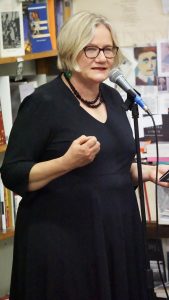
Book Launch, 2018
영국이 호주 아보리진 원주민들의 땅에서 핵 실험을 한 일을 다룬 시를 이곳에서 볼 수 있습니다.
I had a love of poetry from a young age but it was particularly sparked in my 20s when I was living in India. There I discovered Japanese haiku poetry and South Indian devotional poetry. After coming back to Australia, I wrote very little poetry until about 12 years ago when, after 10 years running a Tibetan Buddhist dharma centre, I put aside my committee work and engaged in the live poetry scene here in Melbourne. At the same time, I started photographing the poets in performance. These photos are used by poets for their promotional work including websites and author's photographs in books. Five years ago, I started supporting refugees in Australia's offshore detention camps through listening to their stories, counselling, and advocacy. This also led to writing many poems about this experience. I have a book chapter on Buddhism and human rights in Australia coming out next month which includes one of my poems where I was an audio witness to an armed attack on the refugee camp on Manus Island in Papua New Guinea. I find that poetry is the most accessible and economical way to convey an experience.
You can see my poem about the use of an Australian Aboriginal homeland for British nuclear tests here: http://rightnow.org.au/creative-works/maralinga-nuclear-test-site-south-australia
시드니:
![]() 티베트 역사에 대해 석사학위를 받고 인도 히마찰프라데시에서 박사학위까지 받게 된 경위를 이야기해주세요.
티베트 역사에 대해 석사학위를 받고 인도 히마찰프라데시에서 박사학위까지 받게 된 경위를 이야기해주세요.
How did you come to pursue a master’s in Tibetan History and then eventually a PhD in Himachal Pradesh, India?
디 쿠젠스:
![]() 인도에서 돌아온 20대 후반에 대학에 들어갔어요. 인도 문화와 티베트 불교에 수년 간 깊이 몰입했었기 때문에 공부에 집중할 수 있었습니다. 마침 제가 다니던 라트로브대학에 17세기 중국과 티베트의 관계에 관한 세계 최고의 권위자인 자히루딘 아흐마드 교수가 강의를 하고 있어 행운이었습니다. 2년 만에 학사학위를 받았고, 아흐마드 교수님과의 일대일 수업을 통해 티베트어를 배웠어요. 13세기 역사자료를 번역한 논문이 좋은 평을 받아 석사논문을 쓸 수 있는 장학금을 받았습니다. 석사논문은 티베트의 경전보장품과 19세기 무종파 운동에 대한 내용이었어요. 7년 동안 대학을 다니며 논문을 마칠 무렵 저는 일자리를 찾았야 했어요. 당시 티베트학을 가르칠만한 곳이 없었기에 대학행정 일을 하게 되었습니다. 그 후 저의 티베트어 실력은 많이 줄었지만 공부는 계속했어요. 2004년 모나쉬대학에서 근무하고 있을 때, 박사학위 장학금을 신청해보라는 제의를 받았어요. 주제는 제가 알아서 정하면 되었죠. 인도 히마찰프라데시 주 라훌이라는 지역의 한 골짜기에 아름다운 백색 대리석 관음상을 세운 트리록낫사원으로 가서 연구하기로 결정했습니다. 라훌에 관해 아무 정보도 없었기 때문에 텐진 빠모스님께 여쭤봤죠. 스님은 라훌에 있는 다른 골짜기에서 수행을 하셨었다며 다른 분에게 저의 통역을 부탁하셨어요. 트리록낫사원은 연간 4만 명이 수행하러 오는데 중국 국경부근의 제한구역에 위치해서 4개월을 머무르려면 특별허가를 받아야만 했어요. 그곳 사람들은 히말라야 지역의 글자가 없는 여러 방언을 사용했기 때문에 사원의 전통 역사를 연구하려면 통역이 상당히 중요한 역할을 했습니다.
인도에서 돌아온 20대 후반에 대학에 들어갔어요. 인도 문화와 티베트 불교에 수년 간 깊이 몰입했었기 때문에 공부에 집중할 수 있었습니다. 마침 제가 다니던 라트로브대학에 17세기 중국과 티베트의 관계에 관한 세계 최고의 권위자인 자히루딘 아흐마드 교수가 강의를 하고 있어 행운이었습니다. 2년 만에 학사학위를 받았고, 아흐마드 교수님과의 일대일 수업을 통해 티베트어를 배웠어요. 13세기 역사자료를 번역한 논문이 좋은 평을 받아 석사논문을 쓸 수 있는 장학금을 받았습니다. 석사논문은 티베트의 경전보장품과 19세기 무종파 운동에 대한 내용이었어요. 7년 동안 대학을 다니며 논문을 마칠 무렵 저는 일자리를 찾았야 했어요. 당시 티베트학을 가르칠만한 곳이 없었기에 대학행정 일을 하게 되었습니다. 그 후 저의 티베트어 실력은 많이 줄었지만 공부는 계속했어요. 2004년 모나쉬대학에서 근무하고 있을 때, 박사학위 장학금을 신청해보라는 제의를 받았어요. 주제는 제가 알아서 정하면 되었죠. 인도 히마찰프라데시 주 라훌이라는 지역의 한 골짜기에 아름다운 백색 대리석 관음상을 세운 트리록낫사원으로 가서 연구하기로 결정했습니다. 라훌에 관해 아무 정보도 없었기 때문에 텐진 빠모스님께 여쭤봤죠. 스님은 라훌에 있는 다른 골짜기에서 수행을 하셨었다며 다른 분에게 저의 통역을 부탁하셨어요. 트리록낫사원은 연간 4만 명이 수행하러 오는데 중국 국경부근의 제한구역에 위치해서 4개월을 머무르려면 특별허가를 받아야만 했어요. 그곳 사람들은 히말라야 지역의 글자가 없는 여러 방언을 사용했기 때문에 사원의 전통 역사를 연구하려면 통역이 상당히 중요한 역할을 했습니다.
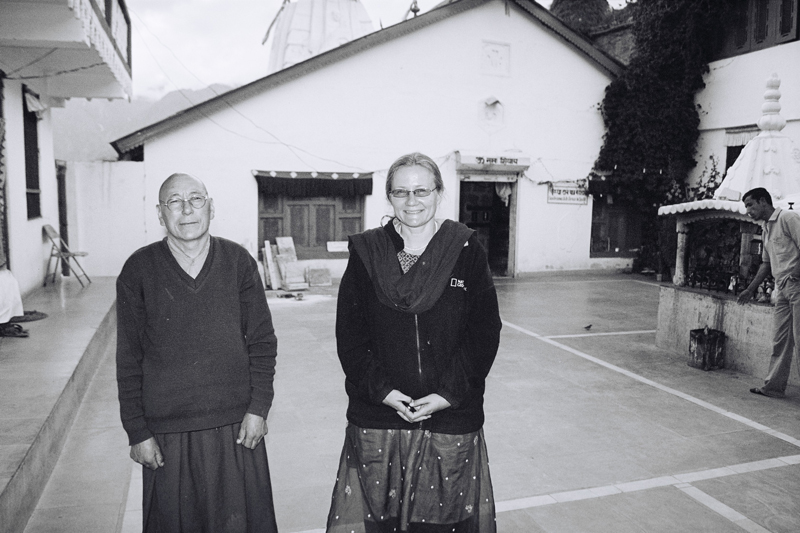
Lahul, 2006
I started my university studies after returning from India in my late 20s, so I had already been exposed to many years of immersion in Indian culture and Tibetan Buddhism. This provided a focus and I was fortunate in that the world's greatest authority on Sino-Tibetan relations in the seventeenth century, Zahiruddin Ahmad, was a lecturer at my university, La Trobe. I did my Honours year over the span of two years and learnt Tibetan with him, one-on-one. I also translated historical materials from the thirteenth century for my Honours thesis. This was well received and led to a scholarship to write a Master’s thesis, which was on the Tibetan treasure tradition and non-sectarian movement of the nineteenth century. By the end of that, I had been a university student for seven years and needed to get a job, so eventually I moved into university administration, as there were no Tibetological teaching posts. Unfortunately, my Tibetan language skills have since atrophied. I remained friends with others in the field and, in 2004 while working at Monash University, I was invited to apply for a PhD scholarship - I just had to propose a topic. I chose the Triloknath temple in Himachal Pradesh because someone had told me that there was a very beautiful white Avalokitesvara - Kuan Yin - there, in a valley in Lahul. I didn't know anything about Lahul but when I asked Jetsunma Tenzin Palmo for her help she said that she had done her retreat in a different valley in Lahul, and she asked her former retreat attendant to be my interpreter. The temple has about 40,000 pilgrims each year, but it is in a restricted area, near the border with China, and I had to get special permission to stay there for four months. The people speak a range of Himalayan dialects which are not written down, so the interpreter was extremely important in finding out the folk history of the temple.
시드니:
![]() 불교를 언제 처음 접하게 되셨나요? 어떠셨어요?
불교를 언제 처음 접하게 되셨나요? 어떠셨어요?
When did you first encounter Buddhism? What were thoughts at that time?
디 쿠젠스:
![]() 불교는 5살 때 처음 접했어요. 짧은 여행 중에 방콕에서 옥으로 만든 불상을 보았고 홍콩에서 여러 불교 사원을 들렀어요. 환생과 보살에 관한 이야기가 재미있었지만 저에겐 낯설고 이질적이었습니다. 19살정도 되었을 때 미얀마의 파간이라는 곳에 처음 가보았는데, 그곳의 성스러움에 가슴이 벅차 올랐습니다. 그 때 보통 사람이라도 누구나 깨달음을 얻을 수 있다는 가이드의 설명을 듣고 처음으로 다가갈 수 있는 영역이라는 생각이 들었어요. 인도에서 만난 티베트 스님들에게서 불교의 복잡한 사상에 대한 설명을 듣고는 이것이 제가 가야 하는 길임을 알게 되었어요. 공 사상과 보리심에 대한 개념이 특별히 더 충격이었습니다.
불교는 5살 때 처음 접했어요. 짧은 여행 중에 방콕에서 옥으로 만든 불상을 보았고 홍콩에서 여러 불교 사원을 들렀어요. 환생과 보살에 관한 이야기가 재미있었지만 저에겐 낯설고 이질적이었습니다. 19살정도 되었을 때 미얀마의 파간이라는 곳에 처음 가보았는데, 그곳의 성스러움에 가슴이 벅차 올랐습니다. 그 때 보통 사람이라도 누구나 깨달음을 얻을 수 있다는 가이드의 설명을 듣고 처음으로 다가갈 수 있는 영역이라는 생각이 들었어요. 인도에서 만난 티베트 스님들에게서 불교의 복잡한 사상에 대한 설명을 듣고는 이것이 제가 가야 하는 길임을 알게 되었어요. 공 사상과 보리심에 대한 개념이 특별히 더 충격이었습니다.
I first encountered Buddhism when I was five years old and was taken to see the Emerald Buddha in Bangkok and other Buddhist temples in Hong Kong on a short trip. I was told about the ideas of reincarnation and bodhisattvas and they seemed interesting but foreign. When I first went travelling around 18 to 19 years-old, I visited Pagan in Burma and was overwhelmed by the sanctity of the place. At that time, the guide explained that enlightenment was possible for ordinary people and, for the first time, this seemed something relatable that one could engage with. When I met Tibetan lamas in India, they were able to explain complex Buddhist ideas and then I realised I had found my path. I was particularly struck by the ideas of sunyata and bodhicitta.
시드니:
![]() 사캬디타 호주의 초대 회장으로서 가장 중요하다고 생각하는 성과는 무엇인가요?
사캬디타 호주의 초대 회장으로서 가장 중요하다고 생각하는 성과는 무엇인가요?
As the first President of Sakyadhita Australia, what would you consider to be some of Sakyadhita Australia’s most significant achievements?
디 쿠젠스:
![]() 샤캬디타 호주는 모든 종파의 불교여성들이 전국 포럼을 통해 서로에게 말할 수 있는 대화의 구조를 구축했어요. 그 자체가 중요한 성과라고 생각합니다. 현 회장인 헬렌 리차드슨은 가정폭력예방 프로젝트에 많은 도움을 주고 있습니다. 전국민에게 이 프로젝트의 결과를 알려서 중요한 영향을 줄 것이라고 기대됩니다. 가장 큰 사회적 성과라면 바로 2019년 시드니 블루마운틴에서 열린 샤캬디타 국제대회죠. 대회 개최를 준비하는 것은 결코 쉬운 일이 아니었습니다. 샤캬디타 인터내셔널 회장인 텐진 빠모스님을 비롯하여 발표자 몇 분들의 비자를 겨우 받았습니다. 세계 여러 지부의 가족이 한 자리에 모여서 이야기도 하고 의견도 서로 나눌 수 있어서 정말 좋았습니다. 저는 샤카디타 호주가 창립된 첫 해인 2016년부터 2017년까지 회장직을 맡았어요. 2015년 인도네시아 족자카르타에서 열린 대회에서 비공식 회의를 가졌고, 기초작업이 마련 되었죠. 샤카디타 호주와 같이 풀뿌리 불교단체에서 저는 대체로 시스템과 구조를 구축합니다. 단체를 등록하고, 웹 도메인을 만들고, 뉴스레터를 제작하고, 사람들을 모아서 위원회를 구성하는 일 등을 하죠. 눈에 보이지 않는 밑작업이지만 표면에 나타나는 각종 일들의 바탕을 마련하는 일입니다.
샤캬디타 호주는 모든 종파의 불교여성들이 전국 포럼을 통해 서로에게 말할 수 있는 대화의 구조를 구축했어요. 그 자체가 중요한 성과라고 생각합니다. 현 회장인 헬렌 리차드슨은 가정폭력예방 프로젝트에 많은 도움을 주고 있습니다. 전국민에게 이 프로젝트의 결과를 알려서 중요한 영향을 줄 것이라고 기대됩니다. 가장 큰 사회적 성과라면 바로 2019년 시드니 블루마운틴에서 열린 샤캬디타 국제대회죠. 대회 개최를 준비하는 것은 결코 쉬운 일이 아니었습니다. 샤캬디타 인터내셔널 회장인 텐진 빠모스님을 비롯하여 발표자 몇 분들의 비자를 겨우 받았습니다. 세계 여러 지부의 가족이 한 자리에 모여서 이야기도 하고 의견도 서로 나눌 수 있어서 정말 좋았습니다. 저는 샤카디타 호주가 창립된 첫 해인 2016년부터 2017년까지 회장직을 맡았어요. 2015년 인도네시아 족자카르타에서 열린 대회에서 비공식 회의를 가졌고, 기초작업이 마련 되었죠. 샤카디타 호주와 같이 풀뿌리 불교단체에서 저는 대체로 시스템과 구조를 구축합니다. 단체를 등록하고, 웹 도메인을 만들고, 뉴스레터를 제작하고, 사람들을 모아서 위원회를 구성하는 일 등을 하죠. 눈에 보이지 않는 밑작업이지만 표면에 나타나는 각종 일들의 바탕을 마련하는 일입니다.
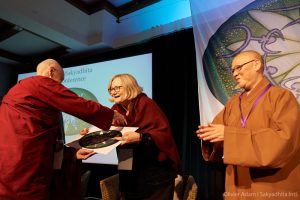
Sakyadhita Conference, 2019
Sakyadhita Australia creates a structure whereby Buddhist women from all traditions can speak to each other through a national forum. On its own, this is a significant achievement. The current president, Helen Richardson, is on the reference group for the BCV family violence project. I expect that this will enable the dissemination of materials and ideas from this project to a national audience, which will also have an important impact. The greatest public achievement is the presentation of the international conference which was held in the Blue Mountains in Sydney in 2019. This was not easy to achieve and the visas for some of our speakers, including international President Jetsunma Tenzin Palmo, were only granted at the last minute! It was wonderful for the full Sakyadhita family to meet together and to share stories and ideas. I was the founding President of Sakyadhita Australia for the first year after incorporation from 2016 to 2017. The groundwork for that was laid at informal meetings held at the Jogjakarta conference in Indonesia in 2015. My contribution to grassroots Buddhist organisations such as Sakyadhita is often in the form of building systems and structures. I know how to register organisations and domain names, write newsletters and bring people together to form committees. This is often invisible 'back end' work but it lies underneath what happens in the public domain.
시드니:
![]() 호주의 불교 사회와 비구, 비구니 스님들의 성평등은 어떠한가요?
호주의 불교 사회와 비구, 비구니 스님들의 성평등은 어떠한가요?
How is the Buddhist community in Australia, and what is the situation like in terms of gender equality among Australian Buddhist monks and nuns?
디 쿠젠스:
![]() 호주에는 다양한 불교커뮤니티가 있어서 여러 전통의 사람들이 자신의 목소리를 낼 수 있습니다. 비구니 스님보다 비구 스님이 그 수가 많은데다 대체로 중요한 역할을 맡고 있어요. 불교가 뿌리내린 지 오래된 지역의 여러 공동체는 비구니 스님들을 후원하기도 하고 교육의 역할을 맡기는 경우도 있어요. 히말라야 지역 이외의 비구니 스님을 위한 연합에 대해 연구 논문을 쓴 적이 있어요. 텐진 빠모스님이 이 연합의 의장을 맡고 계시죠. 티베트 불교에서는 대체로 티베트 출신이 아닌 비구니 스님들의 후원 문제가 심각합니다. 호주나 다른 여러 나라에서도 일어나는 문제죠. 오래전부터 저는 샤카디타 호주의 주도 하에 호주 비구니 스님들의 상황이나 후원 문제 등을 해결하기 위해 현황조사를 시도하고 있지만 아직도 정확한 데이터를 확보하지 못했습니다.
호주에는 다양한 불교커뮤니티가 있어서 여러 전통의 사람들이 자신의 목소리를 낼 수 있습니다. 비구니 스님보다 비구 스님이 그 수가 많은데다 대체로 중요한 역할을 맡고 있어요. 불교가 뿌리내린 지 오래된 지역의 여러 공동체는 비구니 스님들을 후원하기도 하고 교육의 역할을 맡기는 경우도 있어요. 히말라야 지역 이외의 비구니 스님을 위한 연합에 대해 연구 논문을 쓴 적이 있어요. 텐진 빠모스님이 이 연합의 의장을 맡고 계시죠. 티베트 불교에서는 대체로 티베트 출신이 아닌 비구니 스님들의 후원 문제가 심각합니다. 호주나 다른 여러 나라에서도 일어나는 문제죠. 오래전부터 저는 샤카디타 호주의 주도 하에 호주 비구니 스님들의 상황이나 후원 문제 등을 해결하기 위해 현황조사를 시도하고 있지만 아직도 정확한 데이터를 확보하지 못했습니다.
The Buddhist community is very diverse in Australia and traditions from most countries are represented. There are more monks than nuns and monks generally have more senior roles than nuns. Within the communities where Buddhism has been long established, nuns are supported and may have teaching roles. I wrote a research paper for a conference on the Alliance for Non-Himalayan Nuns - https://allianceofnonhimalayannuns.org/ - which is chaired by Jetsunma Tenzin Palmo. In general, nuns in the Tibetan tradition who are not ethnically Tibetan have serious issues with support and this issue applies in Australia and internationally. I have long called for a census to be conducted by Sakyadhita Australia of all the nuns in Australia so that we can definitely establish the situation of nuns and their needs. At present, we do not have precise data.
시드니:
![]() 이번 코로나 팬데믹을 겪으면서 많은 사람들이 위기극복과 중심잡기의 방법으로 명상과 불교수행에 관심을가지고 있습니다. 호주의 상황은 어떤지, 이와 같은 세계적인 고통 속에서 불교가 우리에게 어떤 교훈을 가르쳐 준다고 생각하는지 말씀해주세요.
이번 코로나 팬데믹을 겪으면서 많은 사람들이 위기극복과 중심잡기의 방법으로 명상과 불교수행에 관심을가지고 있습니다. 호주의 상황은 어떤지, 이와 같은 세계적인 고통 속에서 불교가 우리에게 어떤 교훈을 가르쳐 준다고 생각하는지 말씀해주세요.
As we’re currently going through a global pandemic, many people have gravitated towards meditation and Buddhist practices as a means of coping and re-centering. Do you notice this trend in Australia as well, and what lessons do you think Buddhism can teach us when dealing with this sort of global suffering?
디 쿠젠스:
![]() 네, 현재 상황은 스트레스와 불확실성에 어떻게 대처해야 하는 지 되돌아보는 기회입니다. 우리가 평범한 삶을 당연시해왔다는 사실을 상기시켜 주기도 하죠. 사람들과 모이고, 함께 수행하고, 사찰이나 센터에 방문하는 일을 당연하게 받아들였어요. 저는 이 인터뷰 글을 2020년 9월 멜버른에서 쓰고 있어요. 호주는 지난 3월부터 이런 저런 일로 거리두기 생활을 하고 있습니다. 현재 사회적 거리두기가 높은 단계이기 때문에 회사나 종교시설이 폐쇄됐습니다. 이번 팬데믹에서 배울 수 있는 가장 큰 교훈은 ‘상호의존’입니다. 산스크리트어로 ‘프라티야사뭇파다’라고 하죠. 더 이상 국경으로 나뉘어진 국가나 고립된 개인으로 생각할 수 없습니다. 바이러스는 어떠한 경계라도 넘나들 수 있습니다. 이번에 얻은 경험으로는 우리가 전 세계적인 수준에서 함께 행동하고, 세계적인 문제에 함께 대처할 수 있음을 보여주었습니다. 함께 백신 개발에 힘쓸 수 있으며 모두가 나누어 사용할 수 있습니다. 전부 긍정적입니다. 또한 인간과 자연의 관계에 대해 되돌아보는 기회입니다. 야생동물에서 인간으로 전염된 바이러스가 야생동물들의 착취에 대해 사람들의 관심을 끌었고, 인간으로 하여금 자세히 조사하게 만들었습니다. 이러한 착취를 멈출 수 있기를 바랍니다. 전 세계적인 고통의 경험을 통해 모든 생명과의 상호의존 관계를 깨닫고 공동의 이익을 위해 함께 노력할 수 있기를 바랍니다.
네, 현재 상황은 스트레스와 불확실성에 어떻게 대처해야 하는 지 되돌아보는 기회입니다. 우리가 평범한 삶을 당연시해왔다는 사실을 상기시켜 주기도 하죠. 사람들과 모이고, 함께 수행하고, 사찰이나 센터에 방문하는 일을 당연하게 받아들였어요. 저는 이 인터뷰 글을 2020년 9월 멜버른에서 쓰고 있어요. 호주는 지난 3월부터 이런 저런 일로 거리두기 생활을 하고 있습니다. 현재 사회적 거리두기가 높은 단계이기 때문에 회사나 종교시설이 폐쇄됐습니다. 이번 팬데믹에서 배울 수 있는 가장 큰 교훈은 ‘상호의존’입니다. 산스크리트어로 ‘프라티야사뭇파다’라고 하죠. 더 이상 국경으로 나뉘어진 국가나 고립된 개인으로 생각할 수 없습니다. 바이러스는 어떠한 경계라도 넘나들 수 있습니다. 이번에 얻은 경험으로는 우리가 전 세계적인 수준에서 함께 행동하고, 세계적인 문제에 함께 대처할 수 있음을 보여주었습니다. 함께 백신 개발에 힘쓸 수 있으며 모두가 나누어 사용할 수 있습니다. 전부 긍정적입니다. 또한 인간과 자연의 관계에 대해 되돌아보는 기회입니다. 야생동물에서 인간으로 전염된 바이러스가 야생동물들의 착취에 대해 사람들의 관심을 끌었고, 인간으로 하여금 자세히 조사하게 만들었습니다. 이러한 착취를 멈출 수 있기를 바랍니다. 전 세계적인 고통의 경험을 통해 모든 생명과의 상호의존 관계를 깨닫고 공동의 이익을 위해 함께 노력할 수 있기를 바랍니다.
Yes, I think the current situation helps everyone to reflect on how we manage stress and uncertainty. It also serves to remind us of how much of normal life we take for granted, such as the ability to gather with others and practice together and visit our temples and centres. I am writing from Melbourne in September 2020 and we have been in lockdown of one kind or another since March. At the moment, the lockdown is at a very high level and most businesses and all places of worship are closed. I think the biggest lesson from the pandemic is on the truth of interdependence - in Sanskrit pratityasamutpada. We can no longer imagine ourselves as isolated individuals or countries as having fixed borders. The virus can cross any boundaries. However, the experience of the pandemic has shown that we can act at a global level and we can address global problems. We can work together for a vaccine and share it when it becomes available. These are all positives. I think the pandemic also has to cause us to reflect on our relationship with the natural world. The transmission of the virus from wild animals to humans has highlighted the exploitation of wild animals and has brought that greater scrutiny. It is to be hoped that this exploitation can be stopped. I hope that the experience of global suffering will enable us to realise our interdependence with all life and inspire us to work together for the common good.
시드니:
![]() 샤카디타 코리아 회원들과 나누고 싶은 말씀이 있으신지요?
샤카디타 코리아 회원들과 나누고 싶은 말씀이 있으신지요?
Anything else you’d like to share with members of Sakyadhita Korea?
디 쿠젠스:
![]() 샤카디타는 우리에게 각자의 전통과 국경을 초월해서 함께 작업할 수 있는 기회를 주기 때문에 소중히 여겨야 합니다. 서로 배울 점과 공유할 점이 많습니다. 샤카디타 호주대회에서 열린 한국 워크숍 중에 미혼모들을 돌보는 워크숍은 감동적이었어요. 불교의 가르침을 수행하거나 다른 사람들과 공유하는 방법은 무수히 많습니다. 저는 호주의 주립불교위원회와 호주불교의회연합, 이 두 기관을 대상으로 사찰에서의 장애인 접근성에 관한 정책연구를 했습니다. 불법이 사람들에게 접근하기 어려운 상황들을 찾아내고 그것을 해결하는 일은 큰 도움이 됩니다. 우리가 샤카디타나 사찰을 통해 함께 일을 한다면 창의적인 협동이 가능하며 각자 가진 능력에 의지할 수 있습니다. 이렇게 할 때 우리의 작업은 비로소 수많은 생명들에게 닿을 수 있습니다.
샤카디타는 우리에게 각자의 전통과 국경을 초월해서 함께 작업할 수 있는 기회를 주기 때문에 소중히 여겨야 합니다. 서로 배울 점과 공유할 점이 많습니다. 샤카디타 호주대회에서 열린 한국 워크숍 중에 미혼모들을 돌보는 워크숍은 감동적이었어요. 불교의 가르침을 수행하거나 다른 사람들과 공유하는 방법은 무수히 많습니다. 저는 호주의 주립불교위원회와 호주불교의회연합, 이 두 기관을 대상으로 사찰에서의 장애인 접근성에 관한 정책연구를 했습니다. 불법이 사람들에게 접근하기 어려운 상황들을 찾아내고 그것을 해결하는 일은 큰 도움이 됩니다. 우리가 샤카디타나 사찰을 통해 함께 일을 한다면 창의적인 협동이 가능하며 각자 가진 능력에 의지할 수 있습니다. 이렇게 할 때 우리의 작업은 비로소 수많은 생명들에게 닿을 수 있습니다.
We need to cherish Sakyadhita as it gives us the chance to work together across traditions and across countries. We have much to share and much to learn from each other. I was very touched to attend a workshop at the Sydney Sakyadhita conference with Korean women who were working to support single mothers. There are many different kinds of ways of practising Buddhism and of making it available to others. I wrote the policy on disability access to temples in Australia for both the state Buddhist council and also the Federation of Australian Buddhist Councils, a national body. It is helpful to find out the ways in which the Dharma is hard to access for others and to find ways of making it available. When we work together through Sakyadhita or our own temples we can collaborate creatively and draw on each other's strengths. In this way our work can reach many, many beings.
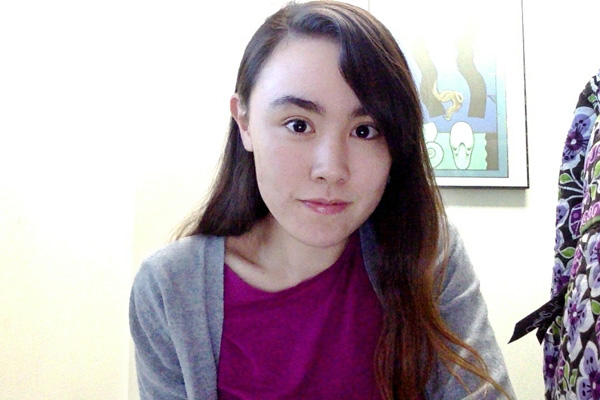 *시드니 탐슨은 샤카디타 코리아 홍보간사를 맡고 있으며, 샤카디타 코리아 뉴스레터 영문판 에디터로 일하고 있습니다.
*시드니 탐슨은 샤카디타 코리아 홍보간사를 맡고 있으며, 샤카디타 코리아 뉴스레터 영문판 에디터로 일하고 있습니다.
*Sydney Thompson is Sakyadhita Korea’s publicity assistant and writer for Sakyadhita Korea’s English content.

